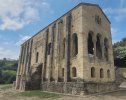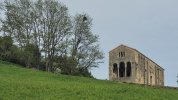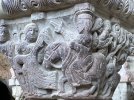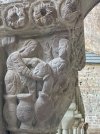- Time of past OR future Camino
- 2012, 2015, 2018, 2019, 2022, 2024
One of the few advantages of Covid, for me at least, was that being unable to walk the camino I was forced to read and learn about it and so I came to the Romanesque, a term used to refer to early Mediaeval architecture. It is really a misnomer apparently devised by early Gothic revivalists (Gothic itself was originally a pejorative and equally inaccurate term) to indicate that it was a style belonging to a culture that had yet to master the pointed arch and was so forced to rely on Roman models. It is a doubly misleading term because not only is the ´following Roman models´ argument questionable, it tends to shift the focus onto architecture and away from sculpture, despite the work of Arthur Kingsley Porter (and his wife) and Meyer Schapiro, and if there is one thing you can say about Romanesque sculpture, it did not follow Roman or Classical models. On the contrary, it completely rejected the idea that sculpture should express noble ideals through representations of the idealised human body. Looked at through 20th or 21st century eyes, it is expressive, lively, sometimes unsophisticated but is always trying to represent humans and their feelings as they really are
I hope that doesn´t sound too pretentious. Anyway, the last couple of caminos I´ve made a conscious effort to photo as much Romanesque and early mediaeval sculpture as I could. I put this video together as a bit of fun. Hope you enjoy it.
I hope that doesn´t sound too pretentious. Anyway, the last couple of caminos I´ve made a conscious effort to photo as much Romanesque and early mediaeval sculpture as I could. I put this video together as a bit of fun. Hope you enjoy it.




















